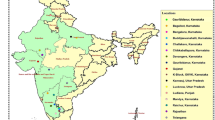Abstract
Plants of Nicandra physaloides, Solanum americanum and Euphorbia heterophylla with leaf lesions have been found naturally grown among tomato plants in commercial fields in Brazil. Tomato bacterial spot was occurring in these fields. Xanthomonad-like isolates were obtained from affected weed leaf samples. These isolates were species identified using BOX-PCR and specific primers. Isolates from N. physaloides and S. americanum were identified as Xanthomonas perforans and that of E. heterophylla were identified as X. gardneri. Each of them was able to artificially infect and cause symptoms on the three weed species and tomato plants.



Similar content being viewed by others
References
Araújo, E. R., Pereira, R. C., Ferreira, M. A. S. V., Café Filho, A. C., Moita, A. W., & Quezado-Duval, A. M. (2011). Effect of temperature on pathogenicity components of tomato bacterial spot and competition between Xanthomonas perforans and X. gardneri. Acta Horticulturae, 914, 39–42.
Araújo, E. R., Costa, J. R., Ferreira, M. A. S. V., & Quezado-Duval, A. M. (2012). Simultaneous detection and identification of the Xanthomonas species complex associated with tomato bacterial spot using species-specific primers and multiplex PCR. Journal of Applied Microbiology, 113, 1479–1490.
Bradbury, J. F. (1986). Guide to plant pathogenic bacteria (p. 244). England: CAB International Mycological Institute.
Costa, J. R., Araújo, E. R., Becker, W. F., Ferreira, M. A. S. V., & Quezado-Duval, A. M. (2012). Ocorrência e caracterização do complexo de espécies causadoras da mancha bacteriana do tomateiro no Alto Vale do Rio do Peixe, SC. Tropical Plant Pathology, 37, 149–154.
Hamza, A. A., Robène-Soustrade, I., Jouen, E., Gagnevin, L., Lefeuvre, P., Chiroleu, F., & Pruvost, O. (2010). Genetic and pathological diversity among Xanthomonas strains responsible for bacterial spot on tomato and pepper in the southwest Indian Ocean region. Plant Disease, 94, 993–999.
Hernandez, D. D., Alves, P. L. C. A., Pavani, M. C. M. D., & Parreira, M. C. (2007). Períodos de interferência de maria-pretinha sobre tomateiro industrial. Horticultura Brasileira, 25, 199–204.
Ignatov, A., Sechler, A., Schuenzel, E. L., Agarkova, I., Oliver, B., Vidaver, A. K., & Schaad, N. W. (2007). Genetic diversity in populations of Xanthomonas campestrispv. campestris in cruciferous weeds in central coastal California. Phytopathology, 97, 803–812.
Jones, J. B., Pohronezny, K. L., Stall, R. E., & Jones, J. P. (1986). Survival of Xanthomonas campestris pv. vesicatoria in Florida on tomato crop residue, weeds, seeds, and volunteer tomato plants. Phytopathology, 76, 430–434.
Jones, J. B., Bouzar, H., Stall, R. E., Almira, E. C., Roberts, P. D., Bowen, B. W., Sudberry, J., Strickler, P. M., & Chun, J. (2000). Systematic analysis of xanthomonads (Xanthomonas spp.) associated with pepper and tomato lesions. International Journal of Systematic and Evolutionary Microbiology, 50, 1211–1219.
Jones, J. B., Lacy, G. H., Bouzar, H., Stall, R. E., & Schaad, N. W. (2004). Reclassification of the xanthomonads associated with bacterial spot disease of tomato and pepper. Systematic and Applied Microbiology, 27, 755–762.
Klement, Z., & Goodman, R. N. (1967). The hypersensitive reaction to infection by bacterial plant pathogens. Annual Review of Phytopathology, 5, 17–44.
Koenraadt, H., van Betteray, B., Germain, R., Hiddink, G., Jones, J. B., Oosterhof, J., Rijlaarsdam, A., Roorda, P., & Wouldt, B. (2009). Development of specific primers for the molecular detection of bacterial spot of pepper and tomato. Acta Horticulturae, 808, 99–102.
Kornev, K. P., Matveeva, E. V., Pekhtereva, E. S. H., Polityko, V. A., Ignatov, A. N., Punina, N. V., & Schaad, N. W. (2009). Xanthomonas species causing bacterial spot of tomato in the Russian Federation. Acta Horticulturae, 808, 243–246.
Mahuku, G. S. (2004). A simple extraction method suitable for PCR-based analysis of plant, fungal, and bacterial DNA. Plant Molecular Biology Reporter, 22, 71–81.
Myung, I.-S., Moon, S. Y., Jeong, I. H., Lee, Y.-K., Lee, Y.-H., & Ra, D. S. (2009). Bacterial spot of tomato caused by Xanthomonas perforans, a new disease in Korea. Plant Disease, 93, 1349.
Nascente, A. S., Pereira, W., & Medeiros, M. A. (2004). Interferência das plantas daninhas na cultura do tomate para processamento. Horticultura Brasileira, 22, 602–606.
Pereira, R. C., Araújo, E. R., Ferreira, M. A. S. V., & Quezado-Duval, A. M. (2011). Occurrence of Xanthomonas species causing bacterial spot in fresh market tomato fields in Brazil. Acta Horticulturae, 914, 61–64.
Quezado-Duval, A. M., & Lopes, C. A. (2010). Mancha bacteriana: uma atualização para o sistema de produção integrada de tomate indústria. 28 p. Brasília: Embrapa Hortaliças, (Circular Técnica 84).
Quezado-Duval, A. M., Leite Júnior, R. P., Lopes, C. A., Lima, M. F., & Camargo, L. E. A. (2005). Diversity of Xanthomonas spp. associated with bacterial spot of processing tomatoes in Brazil. Acta Horticulturae, 695, 101–108.
Schaad, N. W., Jones, J. B., & Chun, W. (2001). Laboratory guide for identification of plant pathogenic bacteria. St Paul: American Phytopathological Society Press.
Sigee, D. C. (1993). Bacterial plant pathology. Cambridge: Cambridge University Press.
Versalovic, J., Koeuth, T., & Lupski, J. R. (1991). Distribution of repetitive DNA sequences in eubacteria and application to fingerprinting of bacterial genomes. Nucleic Acids Research, 19, 6823–6831.
Young, J. M., Park, D.-C., Shearman, H. M., & Fargier, E. (2008). A multilocus sequence analysis of the genus Xanthomonas. Systematic and Applied Microbiology, 31, 366–377.
Acknowledgments
We acknowledge The Foundation for Research Support of the State of Goiás and Embrapa for financial support (grant n° 005/2012 and project 02120101100, respectively).
Author information
Authors and Affiliations
Corresponding author
Rights and permissions
About this article
Cite this article
Araújo, E.R., Costa, J.R., Pontes, N.C. et al. Xanthomonas perforans and X. gardneri associated with bacterial leaf spot on weeds in Brazilian tomato fields. Eur J Plant Pathol 143, 543–548 (2015). https://doi.org/10.1007/s10658-015-0705-9
Accepted:
Published:
Issue Date:
DOI: https://doi.org/10.1007/s10658-015-0705-9




